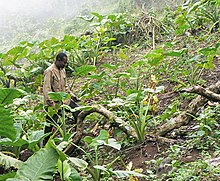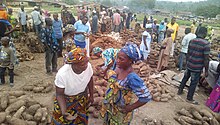Farmers Grow Only Enough Food to Support Themselves and Their Families


Subsistence farmers selling their produce

Subsistence agronomics occurs when farmers grow food crops to come across the needs of themselves and their families on smallholdings.[1] Subsistence agriculturalists target farm output for survival and for generally local requirements, with little or no surplus. Planting decisions occur principally with an eye toward what the family will need during the coming year, and only secondarily toward marketplace prices.[1] Tony Waters, a professor of sociology, defines "subsistence peasants" as "people who grow what they eat, build their own houses, and live without regularly making purchases in the marketplace."[ii] : 2
Despite the self-sufficiency in subsistence farming, today[update] well-nigh subsistence farmers also participate in merchandise to some degree. Although their amount of merchandise as measured in greenbacks is less than that of consumers in countries with modern complex markets, they use these markets mainly to obtain goods non to support income for food. This is usually for goods that are not necessary for survival, which may include sugar, iron roofing-sheets, bicycles, used wearable, so along. Many have important trade contacts and trade items that they can produce because of their special skills or special access to resources valued in the marketplace.[3]
Most subsistence farmers today operate in developing countries.[iii] Subsistence agriculture generally features: small upper-case letter/finance requirements, mixed cropping, limited use of agrochemicals (eastward.k. pesticides and fertilizer), unimproved varieties of crops and animals, picayune or no surplus yield for sale, use of rough/traditional tools (due east.grand. hoes, machetes, and cutlasses), mainly the production of food crops, small scattered plots of land, reliance on unskilled labor (often family unit members), and (generally) depression yields.
History [edit]
Subsistence agriculture was the dominant style of production in the globe until recently, when market-based capitalism became widespread.[iv]
Subsistence agriculture largely disappeared in Europe by the offset of the twentieth century. It began to decrease in North America with the motion of sharecroppers and tenant farmers out of the American South and Midwest during the 1930s and 1940s.[two] [ page needed ] In Cardinal and Eastern Europe, semi-subsistence agronomics reappeared within the transition economy afterward 1990 but declined in significance (or disappeared) in virtually countries past the accession to the European union in 2004 or 2007.[v]
Areas where subsistence farming is largely practiced today, such as India and other regions in Asia, take seen a contempo decline in the practice. This is due to processes such every bit urbanization, transformation of land in rural areas, and integration of capitalist forms of farming.[vi]
Contemporary practices [edit]
Subsistence farming continues today in large parts of rural Africa,[7] and parts of Asia and Latin America. In 2015, about ii billion people (slightly more than 25% of the world's population) in 500 meg households living in rural areas of developing nations survive as "smallholder" farmers, working less than ii hectares (five acres) of land.[8] Around 98% of China's farmers piece of work on small-scale farms, and China accounts for effectually half of the total earth farms.[eight] In Bharat, 80% of the total farmers are smallholder farmers; Federal democratic republic of ethiopia and Asia have almost xc% being small; while United mexican states and Brazil recorded having 50% and 20% being small.[8]
Types of subsistence farming [edit]
Shifting agronomics [edit]
In this type of farming, a patch of forest country is cleared by a combination of felling (chopping down) and called-for, and crops are grown. After 2–3 years the fertility of the soil begins to decline, the state is abased and the farmer moves to clear a fresh piece of country elsewhere in the forest equally the procedure continues.[ix] While the land is left dormant the forest regrows in the cleared area and soil fertility and biomass is restored. Afterward a decade or more, the farmer may return to the outset slice of state. This grade of agriculture is sustainable at depression population densities, but higher population loads crave more than frequent clearing which prevents soil fertility from recovering, opens upwardly more of the wood awning, and encourages scrub at the expense of big trees, eventually resulting in deforestation and soil erosion.[ten] Shifting cultivation is called dredd in India, ladang in Republic of indonesia, milpa in Central America and Mexico and jhumming in North Due east India.
Primitive farming [edit]
While this "slash-and-burn" technique may describe the method for opening new land, unremarkably the farmers in question have in existence at the same time smaller fields, sometimes just gardens, near the homestead in that location they do intensive "non-shifting" techniques until shortage of fields where they can employ "slash and burn down" to articulate land and (by the burning) provide fertilizer (ash). Such gardens near the homestead often regularly receive household decline, and the manure of any household, chickens or goats are initially thrown into compost piles only to get them out of the way. Yet, such farmers often recognize the value of such compost and apply it regularly to their smaller fields. They also may irrigate part of such fields if they are about a source of h2o. [ commendation needed ]
In some areas of tropical Africa, at least, such smaller fields may be ones in which crops are grown on raised beds. Thus farmers practicing "slash and burn" agronomics are often much more sophisticated agriculturalists than the term "slash and burn down" subsistence farmers suggests. [ citation needed ]
Nomadic herding [edit]
In this type of farming people migrate along with their animals from i place to another in search of fodder for their animals. More often than not they rear cattle, sheep, goats, camels and/or yaks for milk, skin, meat and wool.[xi] This manner of life is common in parts of primal and western asia, Bharat, east and southwest Africa and northern Eurasia. Examples are the nomadic Bhotiyas and Gujjars of the Himalayas. They carry their belongings, such as tents, etc., on the backs of donkeys, horses, and camels.[12] In mountainous regions, like Tibet and the Andes, yak and llama are reared. Reindeer are the livestock in arctic and sub-arctic areas. Sheep, goats, and camels are mutual animals, and cattle and horses are besides important.[11] [xiii]
Intensive subsistence farming [edit]
In intensive subsistence agriculture, the farmer cultivates a small plot of land using uncomplicated tools and more labour.[fourteen] Climate with large number of days with sunshine and fertile soils, permits growing of more than than one crop annually on the aforementioned plot. Farmers use their small land holdings to produce enough for their local consumption, while remaining produce is used for substitution against other appurtenances. It results in much more nutrient being produced per acre compared to other subsistence patterns. In the almost intensive situation, farmers may even create terraces along steep hillsides to cultivate rice paddies. Such fields are found in densely populated parts of Asia, such every bit in the Philippines. They may likewise intensify by using manure, artificial irrigation and animal waste equally fertilizer. Intensive subsistence farming is prevalent in the thickly populated areas of the monsoon regions of south, southwest, and southeast Asia.[14]
Poverty alleviation [edit]
Subsistence agronomics tin be used as a poverty alleviation strategy, specifically as a safety net for food-toll shocks and for food security. Poor countries are limited in fiscal and institutional resources that would allow them to contain rises in domestic prices besides as to manage social aid programs, which is often because they are using policy tools that are intended for middle- and high-income countries.[xv] Low-income countries tend to have populations in which fourscore% of poor are in rural areas and more than xc% of rural households have access to land, yet a bulk of these rural poor take insufficient admission to food.[15] Subsistence agronomics tin be used in low-income countries equally a part of policy responses to a nutrient crisis in the short and medium term, and provide a rubber cyberspace for the poor in these countries.[xv]
Run across also [edit]
- Back-to-the-land move
- Greenbacks crop
- Commercial agronomics
- Extensive agriculture
- Hoe-farming
- Industrial agronomics
- Opium replacement
- Subsistence economy
- Subsistence fishing
- Urban agriculture
- Allotment (gardening)
- Permaculture
- Smallholding
References [edit]
- ^ a b Bisht, I. S.; Pandravada, S. R.; Rana, J. C.; Malik, S. K.; Singh, Archna; Singh, P. B.; Ahmed, Firoz; Bansal, K. C. (2014-09-14). "Subsistence Farming, Agrobiodiversity, and Sustainable Agriculture: A Case Written report". Agroecology and Sustainable Nutrient Systems. 38 (8): 890–912. doi:10.1080/21683565.2014.901273. ISSN 2168-3565. S2CID 154197444.
- ^ a b Waters, Tony (2008). The persistence of subsistence agriculture : life below the level of the market. Lexington Books. ISBN978-0-7391-5876-0. OCLC 839303290.
- ^ a b Miracle, Marvin P. (1968). "Subsistence Agriculture: Analytical Problems and Alternative Concepts". American Journal of Agricultural Economics. fifty (two): 292–310. doi:10.2307/1237543. JSTOR 1237543.
- ^ George Reisman. "Capitalism" (1990), p.xvi
- ^ Steffen Abele and Klaus Frohberg (Eds.). "Subsistence Agriculture in Central and Eastern Europe: How to Break the Brutal Circle?" Studies on the Agricultural and Food Sector in Primal and Eastern Europe. IAMO, 2003. Archived 2011-07-19 at the Wayback Machine
- ^ Majumdar, Koustab (2020-04-09). "Rural Transformation in India: Deagrarianization and the Transition from a Farming to Non-farming Economy". Journal of Developing Societies. 36 (2): 182–205. doi:10.1177/0169796x20912631. ISSN 0169-796X.
- ^ Goran Hyden. Across Ujamaa in Tanzania: Underdevelopment and an Uncaptured Peasantry. Berkeley: Academy of California Press. 1980.
- ^ a b c Rapsomanikis, George (2015). "The economic lives of smallholder farmers" (PDF). Food and Agriculture Arrangement of the United nations. p. 9. Archived (PDF) from the original on 2016-05-04. Retrieved 2018-01-11 .
About ii-thirds of the developing globe's iii billion rural people live in most 475 1000000 small farm households, working on land plots smaller than two hectares.
- ^ "Community Forestry: Forestry Note 8". world wide web.fao.org . Retrieved 2020-05-30 .
- ^ "Soil Erosion from Shifting Cultivation and Other Smallholder Land Use in Sarawak, Malaysia". Agriculture Ecosystems & Surroundings. iv (42).
- ^ a b Miggelbrink, Judith. (2016). Nomadic and indigenous spaces : productions and cognitions. Routledge. ISBN978-1-315-59843-seven. OCLC 953047010.
- ^ Hymer, Stephen (Jump 2018). "Economic Forms in Pre-Colonial Ghana". Economic History Clan. xxx (1): 33–50. doi:10.1017/S0022050700078578. hdl:10419/160011. JSTOR 2116722.
- ^ Miggelbrink, Judith, editor. Habeck, Joachim Otto, editor. Mazzullo, Nuccio, editor. Koch, Peter, editor. (xv November 2016). Nomadic and indigenous spaces : productions and cognitions. ISBN978-1-138-26721-iii. OCLC 1010537015. CS1 maint: multiple names: authors list (link)
- ^ a b Vaughn, Sharon; Wanzek, Jeanne (May 2014). "Intensive Interventions in Reading for Students with Reading Disabilities: Meaningful Impacts". Learning Disabilities Inquiry & Practice. 29 (2): 46–53. doi:10.1111/ldrp.12031. ISSN 0938-8982. PMC4043370. PMID 24910504.
- ^ a b c de Janvry, Alain; Sadoulet, Elisabeth (2011-06-01). "Subsistence farming as a safety net for nutrient-cost shocks". Development in Do. 21 (four–5): 472–480. doi:x.1080/09614524.2011.561292. ISSN 0961-4524. S2CID 13891983.
Further reading [edit]
- Charles Sellers (1991). The Market Revolution: Jacksonian America, 1815–1846. New York: Oxford University Press.
- Sir Albert Howard (1943). An Agricultural Testament. Oxford University Press.
- Tony Waters (2010). "Farmer Power: The standing confrontation between subsistence farmers and development bureaucrats"/
- Marvin P Miracle (May 1968). "Subsistence Agronomics: Analytical Problems and Alternative Concepts", American Journal of Agricultural Economic science, pp. 292–310.
Source: https://en.wikipedia.org/wiki/Subsistence_agriculture
0 Response to "Farmers Grow Only Enough Food to Support Themselves and Their Families"
Enregistrer un commentaire